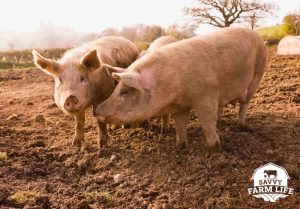
What Are the Best Pig Breeds For Meat?
If you are considering raising pigs on your homestead, you may be planning to raise them for meat. After all, pigs are not raised for milk or for their coat, like other farm animals are. There is really just one commodity that pigs are raised for. So, which breed is right for your homestead?
What are the best pig breeds to raise for meat? You can raise any breed of pig for meat. However, there are a few breeds that excel in terms of quality meat production and mothering abilities. The eight best pig breeds to raise for meat are the:
- Yorkshire Pigs
- Duroc Pigs
- Berkshire Pigs
- Meishan Pigs
- Landrace Pigs
- Chester White Pigs
- Hampshire Pigs
- Pietrain Pigs
These may be the best pig breeds for meat, but what goes into caring for these pigs? How big do they get? Keep reading to learn more!
#1 Pig For Meat: Yorkshire
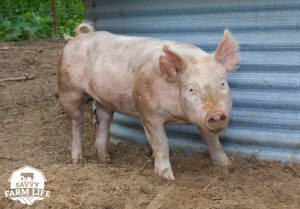 The Yorkshire is the most popular pig breed in North America. This pig is entirely white, with pink skin. Commercial growers prefer white pigs, because the final product is visually more appealing than a carcass with dark hair (this is the same reason most commercial poultry is white in color).
The Yorkshire is the most popular pig breed in North America. This pig is entirely white, with pink skin. Commercial growers prefer white pigs, because the final product is visually more appealing than a carcass with dark hair (this is the same reason most commercial poultry is white in color).
Yorkshires (like all pig breeds with names that end in “-shire”) have erect ears instead of ears that flop over. They are fast-growing and are considered medium-sized pigs that can reach 500 – 750 pounds, depending on the variety you raise. While Yorkshires were originally fattier, they have been bred in the last 100 years to produce more lean meat, so they are an excellent choice if you are looking for lean meat like pork.
Yorkshire sows are excellent mothers, with a strong maternal instinct. They usually produce large litters, averaging between 10 and 12 piglets per litter.
#2 Pig For Meat: Duroc
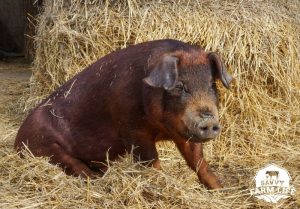 The Duroc is the second most popular breed of pig in North America, with a characteristic red coat and floppy ears. They are docile in temperament, making them a good choice for families.
The Duroc is the second most popular breed of pig in North America, with a characteristic red coat and floppy ears. They are docile in temperament, making them a good choice for families.
Durocs are excellent lean meat producers, reaching 700 – 800 pounds at maturity. They are exceptionally fast-growing, and tend to put on a lot of muscle mass in a short amount of time, as opposed to gaining a lot of fat. This body composition and growth potential makes them another superior choice for lean meat.
Durocs, with their gentle and calm temperaments, typically make excellent mothers and enjoy caring for their young. They average litters of 10 or more piglets at a time. With their thicker skin and hair, they are also a good choice for colder climates.
#3 Pig For Meat: Berkshire
 Another popular meat breed is the Berkshire. Berkshires are black pigs with six areas of white on them – true Berkshires should have white on their faces, tails, and all four feet. Berkshires, as their name implies, have erect ears.
Another popular meat breed is the Berkshire. Berkshires are black pigs with six areas of white on them – true Berkshires should have white on their faces, tails, and all four feet. Berkshires, as their name implies, have erect ears.
Berkshires are considered to be fast growers, though they are not the fastest-growing breed available. Berkshires reach an average of 600 pounds at maturity. They are exceptionally good, caring mothers, and have an average litter size of 9-10 piglets.
Berkshires are unique in their meat quality. They produce superior, marbled meat that is often marketed as a delicacy. The unique marbling quality of Berkshire meat makes it more tender than other pork, and significantly more flavorful. It is also darker in color, and not as lean as the pork from other breeds. If you are looking for a superior, high-quality meat, the Berkshire is an excellent choice.
#4 Pig For Meat: Meishan
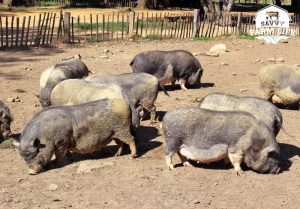 The Meishan may seem like an outlier in our list of pigs for meat production, due to their relatively slower growth rate and pot-bellied appearance. They also are on the smaller size in relation to other meat breeds, reaching an average weight of 350-400 pounds at maturity, and are fattier than other breeds. So what is it that makes the Meishan a contender for one of the best meat breeds?
The Meishan may seem like an outlier in our list of pigs for meat production, due to their relatively slower growth rate and pot-bellied appearance. They also are on the smaller size in relation to other meat breeds, reaching an average weight of 350-400 pounds at maturity, and are fattier than other breeds. So what is it that makes the Meishan a contender for one of the best meat breeds?
Meishans are baby machines. Not only are they excellent mothers – consistently caring for their young until weaning age – but they are famous for their litter sizes. Meishans regularly produce 15-20 piglets per litter, more than any other breed of pig. If you are looking for lots of babies born to caring sows, the Meishan is a great option.
Meishans are also easy to care for – they are docile and very calm, and do not test fences.
#5 Pig For Meat: Landrace
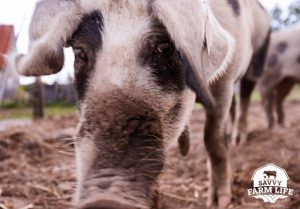 Landraces are white in color and have floppy ears. On average they reach around 500-600 pounds at maturity, and are fast-growing pigs.
Landraces are white in color and have floppy ears. On average they reach around 500-600 pounds at maturity, and are fast-growing pigs.
Landraces are unique in that they have been bred to have significantly longer bodies than other breeds. The longer mid-sections of these pigs lend to larger yields of bacon. Because of their long bodies, they also have larger loins, giving you more pork chops. This unique body composition makes Landraces efficient producers of lean meat.
Landrace sows are excellent mothers, and are known for producing exceptionally large piglets. They typically produce 10-15 large piglets per litter, and because of the size of their young, they may require assistance while birthing.
#6 Pig For Meat: Chester White
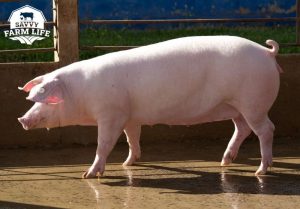 Chester Whites are white in size and have floppy ears. They reach an average of 550-800 pounds at maturity, and are exceptionally fast-growing. Because of this fast growth rate, they are efficient meat producers.
Chester Whites are white in size and have floppy ears. They reach an average of 550-800 pounds at maturity, and are exceptionally fast-growing. Because of this fast growth rate, they are efficient meat producers.
While all of the pigs we have listed so far make good mothers, the Chester White excels at motherhood. In fact, one of the reasons that Chester Whites are so popular is because they are often used for cross-breeding to carry their mothering instincts to other breeds. They have very high conception rates and usually have litters of 10 or more piglets.
#7 Pig For Meat: Hampshire
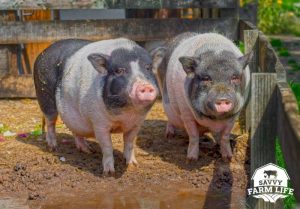 Hampshires have erect ears and are black in color with a white “belt” that completely circles their abdomen. Hampshires are slower-growing than most of the other breeds on this list, but they are known to produce the leanest meat of any other breed commonly raised in North America. Hampshires reach an average of 500-650 pounds at maturity.
Hampshires have erect ears and are black in color with a white “belt” that completely circles their abdomen. Hampshires are slower-growing than most of the other breeds on this list, but they are known to produce the leanest meat of any other breed commonly raised in North America. Hampshires reach an average of 500-650 pounds at maturity.
Hampshires are good mothers and produce an average of 9 piglets per litter. One note about Hampshires: they are potential carriers of PSS (Porcine Stress Syndrome). If a pig has two PSS genes passed down to him, he will be highly susceptible to extreme stress, negatively affecting both his health and his meat quality.
Emotional strain can negatively affect any animal. Being able to recognize pig behavior can help you determine what your pig is feeling. To learn more, visit my article How To Tell If a Pig is Happy: Top Signs To Look For.
#8 Pig For Meat: Pietrain
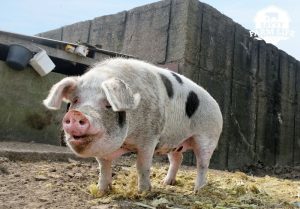 The Pietrain is a white pig with black spots, and has erect ears. They reach 500-600 pounds at maturity and are known to produce a plentiful amount of lean meat. Pietrains are good mothers with a lot of milk, and you can expect more than 10 piglets per litter.
The Pietrain is a white pig with black spots, and has erect ears. They reach 500-600 pounds at maturity and are known to produce a plentiful amount of lean meat. Pietrains are good mothers with a lot of milk, and you can expect more than 10 piglets per litter.
Pietrains are also potential carriers of PSS – so this is something to watch out for. If you decide to raise Hampshires or Pietrains, it would be a good idea to order a genetic test for them and only breed the animals that do not carry the PSS gene.
What Should You Look For In A Meat Pig?
Because pigs are typically only raised for one commodity, you can raise any breed of pig for meat. However, there are pros and cons to the different pig breeds when it comes to meat production.
Specific to meat production, you will want to determine what kind of meat you would most like to get out of your pig. Pigs produce a variety of delicious meat, including pork, ribs, ham, bacon, and sausage. If you are looking for a big pork-producer, you will want a leaner breed of pig. If you are looking for more bacon and sausage, you will want a fattier breed of pig.
Unless you are planning to raise a single pig at a time for meat (which isn’t the most efficient way to go about it, but understandable if you have a limited amount of space), you will also want to look at the litter potential and the mothering abilities of a pig. Some sows (female pigs) are naturally better mothers than others. And some breeds are known for their large litters. The more piglets your sows are producing, the more potential you have for meat.
Lastly, you will want to look at the growth rate of your pigs, and the age at which they reach sexual maturity if you are breeding them. The faster the growth rate, the sooner you can take to slaughter. The sooner you can take to slaughter, the less time and money you will be spending raising the pig. This is an important factor when it comes to efficiency and economics.
Which Pig Breed Is Right For You?
As you can see, there is no shortage of pig breeds that are both excellent meat producers, and prolific breeders. Whichever breed you choose, you will be rewarded with an abundance of high-quality meat and more piglets than you know what to do with.
Did you know you can keep pigs with chickens? This can help you save on space and resources! To learn more, visit my article Can Pigs and Chickens Live Together?
